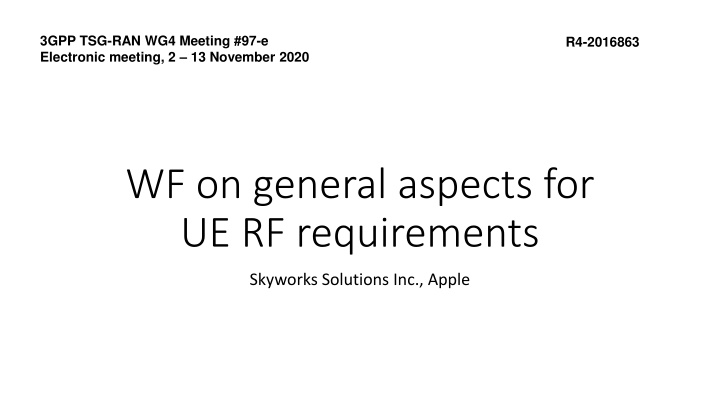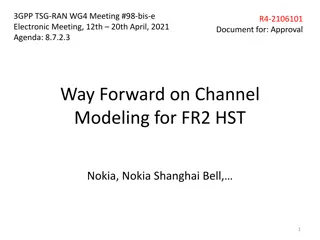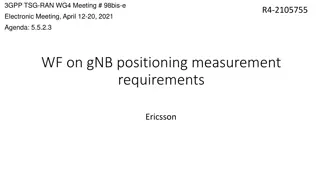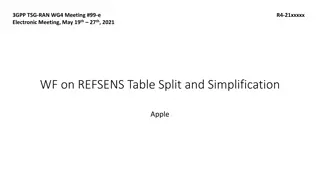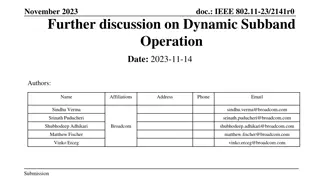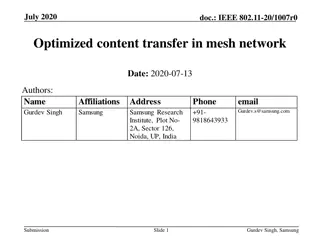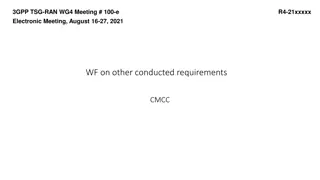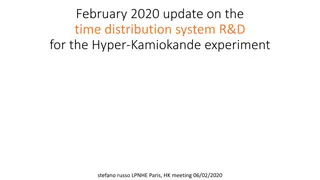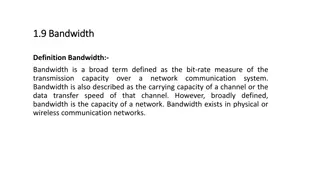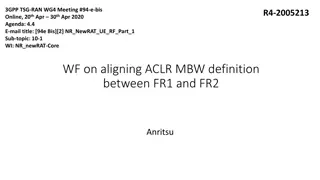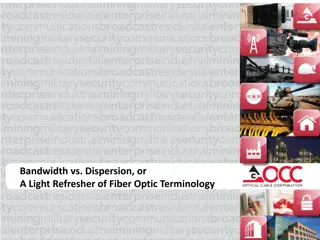Overview of UE RF Requirements for 35/45MHz Channel Bandwidth in 3GPP Meeting #97-e
The document discusses the introduction of 35/45MHz channel bandwidth in UE RF requirements for various bands. It covers equation-based requirements and limitations in UL configurations based on bandwidth allocation. The scope includes capturing content from the first round discussions and clarifying the process. Background information on entering 35/45MHz channel bandwidth is provided for bands covered in the document. Equations and tables related to spectrum emission masks, channel bandwidths, and specific requirements are detailed for different scenarios.
Download Presentation

Please find below an Image/Link to download the presentation.
The content on the website is provided AS IS for your information and personal use only. It may not be sold, licensed, or shared on other websites without obtaining consent from the author.If you encounter any issues during the download, it is possible that the publisher has removed the file from their server.
You are allowed to download the files provided on this website for personal or commercial use, subject to the condition that they are used lawfully. All files are the property of their respective owners.
The content on the website is provided AS IS for your information and personal use only. It may not be sold, licensed, or shared on other websites without obtaining consent from the author.
E N D
Presentation Transcript
3GPP TSG-RAN WG4 Meeting #97-e Electronic meeting, 2 13 November 2020 R4-2016863 WF on general aspects for UE RF requirements Skyworks Solutions Inc., Apple
Scope Capture agreeable content from 1st round discussion on: Equation based requirements and how to introduce 35/45MHz channel BW in tables for bands: WF in slide 4-10 UL configuration limitations based on UL BW or UL RB allocation: WF in slide 14-16 How to introduce 35/45MHz channel BW in tables for band combination is not in scope of this WI but the process is worth clarifying. Slide 12 References of contributions covering these topics are in last slide.
Background on entering 35/45MHz channel BW in UE requirements for bands in the WI: For 38.101-1 the affected generic requirements are: 5.3.2 Maximum transmission bandwidth configuration 6.2.2 UE maximum output power reduction (DMPR for BW criteria) 6.5.1 Occupied bandwidth => may be simplified since occupied channel BW = BWchannel 6.5.2.2 Spectrum emission mask => can use equation based approach 6.5.2.4.1 NR ACLR => ACLR measurement BW 7.4 Maximum input level 7.5 Adjacent channel selectivity => can use equation based approach 7.7 Spurious response => can use equation based approach 7.8.2 Wide band Intermodulation => equation based approach FFS Reference measurement channels For 38.101-1 the affected band specific requirements are: 5.3.5 UE channel bandwidth per operating band 5.3.6 Asymmetric channel bandwidths if UL BW is limited and for n66 and n71 5.3E.2 Channel bandwidth for V2X concurrent operation for n71? 5.4.4 TX RX frequency separation if asymmetric UL/DL is adopted 6.2.3 UE additional maximum output power reduction: adding 35/45MHz BW where necessary A-MPR for NS_03 and NS_03U, NS_46 and NS_35 and associated requirements. => SEM requirements can use equation based approach 7.3.2 Reference sensitivity power level: tables for REFSENS and UL configuration are already wider than the page
WF: R17 Equation based SEM from [1] Table 6.5.2.2-1: General NR spectrum emission mask Channel bandwidth (MHz) / Spectrum emission limit (dBm) 5 10, 15, 20, 25, 30, 35, 40, 45 50, 60, 70, 80, 90, 100 -13 -13 Measurement bandwidth 1 % of channel BW 30 kHz fOOB (MHz) 0-1 0-1 1-5 5-6 6-10 5-BWChannel BWChannel-(BWChannel+5) NOTE 1: Void Equation based approach is adopted for general SEM like table on the right -24 -10 -13 -25 -10 1 MHz -13 -25 Band specific SEM for NS03 and NS_35 adopts the same approach as in respective tables below. Addition of 35MHz and or 45MHz may not be needed depending on UL BW Table 6.5.2.3.3-1: Additional requirements for "NS_03" and "NS_21" Table 6.5.2.3.1-1: Additional requirements for "NS_35" Channel bandwidth (MHz) / Spectrum emission limit (dBm) 5 10 15 -15 -18 -20 -13 -25 Measurement bandwidth fOOB (MHz) Channel bandwidth (MHz) / Spectrum emission limit (dBm) 5 10, 15, 20, 25, 30, 35, 40, 45 -13 -13 -25 Measurement bandwidth fOOB MHz 20 -21 35 0-0.1 0.1-6 6-10 -23.5 30 kHz 100 kHz 1 MHz 100 kHz 1 MHz 0-1 1-6 6-10 1-BWChannel BWChannel- (BWChannel+5) -13 1 % of channel BW 0.1-BWChannel BWChannel-(BWChannel+5) NOTE 1: Void First row could be further simplified with an equation -13 -25 -13 -25 1 MHz
WF: R17 Equation based maximum input power Table 7.4-1: Maximum input level Rx Units Channel bandwidth (MHz) 35 40 -232 -22.52 Parameter Power in Transmission Bandwidth Configuration NOTE 1: The transmitter shall be set to 4 dB below PCMAX_L,f,cat the minimum uplink configuration specified in Table 7.3.2-3 with PCMAX_L,f,cas defined in clause 6.2.4. NOTE 2: Reference measurement channel is A.3.2.3 or A.3.3.3 for 64 QAM. NOTE 3: Reference measurement channel is A.3.2.4 or A.3.3.4 for 256 QAM. 5, 10, 15, 20 -252 25 -242 30 45 50 -212 60, 70, 80, 90, 100 -202 -223 -222 -21.52 dBm -273 -263 -253 -243 -233 Equation based approach is adopted for maximum input power like in above table
WF: R17 Equation based ACS from [1] Table 7.5-1: ACS for NR bands with FDL_high< 2700 MHz and FUL_high< 2700 MHz Table 7.5-2: ACS for NR bands with FDL_low 3300 MHz and FUL_low 3300 MHz Channel bandwidth (MHz) 20, 25, 30, 35, 40, 45, 50, 60, 70, 80, 90, 100 27 10log10(BWChannel/20) Channel bandwidth (MHz) 10, 15, 20, 25, 30, 35, 40, 45, 50, 60, 70, 80, 90, 100 33 RX parameter Units RX parameter Units 5, 10 33 15 30 ACS1 dB ACS dB NOTE 1: ACS value is rounded to the next higher 0.5dB value Table 7.5-3: Test parameters for NR bands with FDL_high< 2700 MHz and FUL_high< 2700 MHz, case 1 Table 7.5-4: Test parameters for NR bands with FDL_high< 2700 MHz and FUL_high< 2700 MHz, case 2 Channel bandwidth (MHz) 20, 25, 30, 35, 40, 45, 50, 60, 70, 80, 90, 100 Channel bandwidth (MHz) 20, 25, 30, 35, 40, 45, 50, 60, 70, 80, 90, 100 RX RX Units Units parameter Power in transmission bandwidth configuration parameter Power in transmission bandwidth configuration1 Pinterferer BWinterferer 5, 10 15 5, 10 15 dBm REFSENS + 14 dB dBm -56.5 -53.5 -50.5 + 10log10(BWChannel/20) REFSENS + 45.5 dB REFSENS + 42.5 dB dBm MHz -25 5 Pinterferer1 dBm REFSENS + 39.5 10log10(BWChannel /20) BWinterferer MHz 5 BWChannel/2 + 2.5 / -(BWChannel/2 + 2.5) Finterferer (offset) BWChannel /2 + 2.5 / -(BWChannel /2 + 2.5) MHz Finterferer (offset) MHz NOTE 1: Power in transmission bandwidth configuration value is rounded to the next higher 0.5dB value NOTE 1: Pinterferer value is rounded to the next higher 0.5dB value Table 7.5-5: Test parameters for NR bands with FDL_low 3300 MHz and FUL_low 3300 MHz, case 1 Table 7.5-6: Test parameters for NR bands with FDL_low 3300 MHz and FUL_low 3300 MHz, case 2 Channel bandwidth (MHz) 10, 15, 20, 25, 30, 35, 40, 45, 50, 60, 70, 80, 90, 100 Channel bandwidth (MHz) 10, 15, 20, 25, 30, 35, 40, 45, 50, 60, 70, 80, 90, 100 RX parameter Units RX parameter Units Power in transmission bandwidth configuration Pinterferer BWinterferer Power in transmission bandwidth configuration Pinterferer BWinterferer dBm REFSENS + 14 dB dBm -56.5 dBm MHz REFSENS + 45.5 dB BWChannel BWChannel / -BWChannel dBm MHz -25 BWChannel BWChannel / -BWChannel Finterferer(offset) MHz Finterferer(offset) MHz
WF: R17 Equation based Blocking from [1] Table 7.6.2-1: In-band blocking parameters for NR bands with FDL_high< 2700 MHz and FUL_high< 2700 MHz Table 7.6.3-1: Out-of-band blocking parameters for NR bands with FDL_high< 2700 MHz and FUL_high< 2700 MHz Channel bandwidth (MHz) 20, 25, 30, 35, 40, 45, 50, 60, 70, 80, 90, 100 RX Channel bandwidth (MHz) 20, 25, 30, 35, 40, 45, 50, 60, 70, 80, 90, 100 RX Units Units parameter Power in transmission bandwidth configuration1 BWinterferer FIoffset, case 1 FIoffset, case 2 NOTE 1: Power in transmission bandwidth configuration value is rounded to the next higher 0.5dB value 5, 10 15 parameter Power in transmission bandwidth configuration1 NOTE 1: Power in transmission bandwidth configuration value is rounded to the next higher 0.5dB value 5, 10 15 REFSENS + 6 dB REFSENS + 7 dB dBm REFSENS + (9 + 10log10(BWChannel/20)) dB REFSENS + 6 dB REFSENS + 7 dB dBm REFSENS + (9 + 10log10(BWChannel/20)) dB dBm MHz MHz 5 7.5 12.5 Table 7.6.3-3: Out-of-band blocking parameters for NR bands with FDL_low 3300 MHz and FUL_low 3300 MHz Table 7.6.2-3: In-band blocking parameters for NR bands with FDL_low 3300 MHz and FUL_low 3300 MHz Channel bandwidth (MHz) 20, 25, 30, 35, 40, 45, 50, 60, 70, 80, 90, 100 RX Channel bandwidth (MHz) 10, 15, 20, 25, 30, 35, 40, 45, 50, 60, 70, 80, 90, 100 Units RX parameter Power in transmission bandwidth configuration Units 10 15 parameter Power in transmission bandwidth configuration BWinterferer FIoffset, case 1 FIoffset, case 2 REFSENS + 6 dB REFSENS + 7 dB dBm REFSENS + 9 dB dBm REFSENS + 6 dB dBm MHz MHz BWChannel (3/2) BWChannel (5/2) BWChannel Equation based approach is adopted for in-band and out of band blocking like in above tables
WF: R17 Equation based Blocking from [1] Table 7.6.4-1: Narrow Band Blocking Channel bandwidth (MHz) 20 25, 30, 35, 40, 45, 50, 60, 70, 80, 90, 100 REFSENS + channel BW specific value below 14 16 -55 Band RX parameter Units 5 10 15 n1, n2, n3, n5, n7, n8, n12, n14, n18, n20, n25, n26, n28, n30, n34, n38, n39, n40, n41, n48, n50, n51, n53, n65, n66, n70, n71, n74, n75, n76n NOTE 1: rounded to half of SCS Pw dBm 16 13 16 Puw(CW) dBm ??? ????? 2 Fuw(offset, SCS = 15 kHz)1 + 0.2 MHz NA + 0.5 + 0.5 ??? ??? ??? ????? 2 Fuw(offset, SCS = 30 kHz)1 + ????,? ????? ??? MHz NA + 0.5 + 0.5 ??? Equation based approach is adopted for narrow band blocking like in above table
WF: R17 Equation based spurious response from [1] Table 7.7-1: Spurious response parameters for NR bands with FDL_high< 2700 MHz and FUL_high< 2700 MHz Channel bandwidth (MHz) 20, 25, 30, 35, 40, 45, 50, 60, 70, 80, 90, 100 RX Units parameter Power in transmission bandwidth configuration1 5, 10 15 REFSENS + 6 dB REFSENS + 7 dB dBm REFSENS + (9 + 10log10(BWChannel/20)) dB NOTE 1: Power in transmission bandwidth configuration value is rounded to the next higher 0.5dB value Table 7.7.1-1a: Spurious response parameters for NR bands with FDL_low 3300 MHz and FUL_low 3300 MHz Channel bandwidth (MHz) 20, 25, 30, 35, 40, 45, 50, 60, 70, 80, 90, 100 RX Unit s parameter Power in transmission bandwidth configuration 10 15 REFSENS + 6 dB REFSENS + 7 dB dBm REFSENS + 9 dB Equation based approach is adopted for spurious response like in above tables
WF on tables where equation based approach can t apply For TX BW, guard bands, occupied BW and ACLR measurement BW: Two additional columns for 35 and 45MHz fit in the pages and will be updated once SU is confirmed. Occupied BW is basically = BWchannel For tables with channel configurations: Tables are already just fitting the page some improvement is needed For REFSENS tables: Tables are already wider than the page and in some case it is difficult to find the associated channel BW with a column Options: Swapping columns and rows have been proposed to reduce width Reducing rows per SCS by introducing coding instead of yes but it does not apply to RESENS tables Instead of yes the BW value could be repeated or a list of BW is used Using page in landscape mode Other
Background on adding 35/45MHz channel BW for bands-combinations: For 38.101-1 the affected band combination specific requirements are: 5.5A Configurations for CA 5.5B Configurations for DC 5.5C Configurations for SUL Associated AMPR SEM tables already uses equation based approach 7.3A.2.4 Reference sensitivity power level for SDL bands Associated REFSENS exceptions for UL harmonics, harmonic mixing and cross band isolation 7.3C.2 Reference sensitivity power level for SUL Blocking and ACS for CA are already equation based Some of WF for band specific requirements can apply to band combinations
Adding 35/45MHz channel BW for bands-combinations For introduction of 35MHz and 45MHz BW in existing band combinations the following rules should apply 35/45MHz BW can only be added to a band combination if the related band specific work is completed in NR_FR1_35MHz_45MHz_BW WI Even if 35/45MHz BW are added to an existing FR1 band combination, it can only be introduced with a TR and not directly as a CR as for any band combination even if >3 band combination. This is because the MSD of its lower order constituents up to 3 should be verified and specified for these new channel BW. If there is existing MSD for the band where the new BWs are introduced is a victim of an UL harmonic or harmonic mixing issue, the MSD values need to be added to the new victim channel BW If there is existing MSD for the band where the new BWs are introduced is a victim of a cross band isolation issue, the MSD values need to be added to the new victim channel BW If there is existing MSD for the band where the new BWs are introduced is an aggressor of a cross band isolation issue, the UL configuration values need to be added to the new victim channel BW. In the case where the new introduced channel BW is the largest one even if cross band isolation issue does not exist for lower channel BW, it should be studied if the issue could exist as an aggressor or a victim. In the case of adding new BW to intra-band UL/DL CA MSD and AMPR issues also need attention. Although this process for the 35/45MHz introduction in band-combination is discussed as an outcome of completion of a band in NR_FR1_35MHz_45MHz_BW WI it could also apply for completion of a band in NR_bands_R17_BWs WI. To crystalize and finalize this process it is proposed that an example combination is studied within either NR_FR1_35MHz_45MHz_BW or NR_bands_R17_BWs or other WI to develop a template.
Background on UL configuration and UL BW limitation : There are a few aspects where UL BW play a role: MPR when FDD BW >3% or TDD BW>4%, This is the case for n8 and n71 The new BW becomes the larger BW: MSD related to cross band isolation may have to be considered Same for some band protection Larger A-MPR may be required Beyond BB capability there may be BW limitations on the transmitter on legacy devices For FDD bands with small duplex, large MSD and large A-MPR have laready been observed by measurements For n8 and n71 all of the above aspects are relevant as discussed in [2] For n25 45 MHz is the largest UL channel BW and has ACLR1 overlap with DL channel => large MSD
WF on n8 and n71 UL BW: Option1: UL BW is limited to 20 MHz No need for MPR, NS_43 and NS_35 A-MPR and associated SEM requirements No issue with other band protection Low MSD can be specified using current 20MHz UL configuration: Option 1a: Worst case 20MHz UL closest to DL Option 1b: Best case 20MHz UL furthest to DL Option 1c: both 1b and 1c are specified Limited impact to band combinations Option2: 35MHz UL BW is supported Need for MPR, NS_03 and NS_35 A-MPR and associated SEM requirements Large MSD with further reduced UL configuration and A-MPR are specified which does not help the link throughput Potential additional work for band combinations with n8 or n71 UL WF: Option 1 is chosen and exact 20MHz UL configuration can be part of WF R4- 2016864 by selecting sub options a, b or c
WF on n25 UL BW: Option1: UL BW is limited to 40 MHz No need for NS_03 and associated SEM requirements for 35MHz Low MSD can be specified using current 40MHz UL configuration: Option 1a: Worst case 40MHz UL closest to DL Option 1b: Best case 40MHz UL furthest to DL Option 1c: both 1b and 1c are specified Limited impact to band combinations Option2: 45MHz UL BW is supported Need for NS_03 and associated SEM requirements Large MSD with further reduced UL configuration are specified which does not help the link throughput Potential additional work for band combinations with n25 UL WF: Option 1 and Option 2 can be further discussed and selected in WF R4- 2016864
References: [1] R4-2014911 UE RF requirements tables with channel BW dependency Apple Inc. [2] R4-2015800 Specification impact of additional 35&45MHz channel bandwidths Skyworks Solutions Inc. [3] R4-2014173 35M_45M AMPR, MPR, REFSENS Qualcomm Incorporated [4] R4-2016010 n71 35MHz AMPR and MSD Measurements Skyworks Solutions Inc. [5] R4-2016011 n8 35MHz AMPR and MSD Measurements Skyworks Solutions Inc. [6] R4-2016027 n7 35MHz AMPR and MSD Measurements Skyworks Solutions Inc. [7] R4-2016295 Introduction of 35 MHz for n8, n66, n71 and 45 MHz for n66 Apple Inc. [8] R4-2016060 Introduction of 35MHz and 45MHz regarding CA, DC, V2x combinations Ericsson [9] R4-2015044 On UE RF requirement for new channel bandwidth of 35MHz and 45MHz ZTE Corporation
